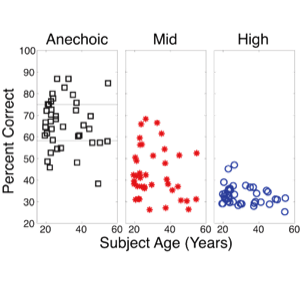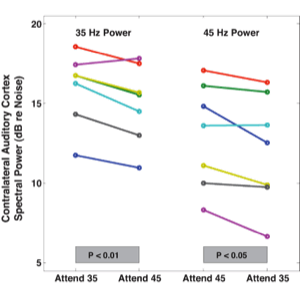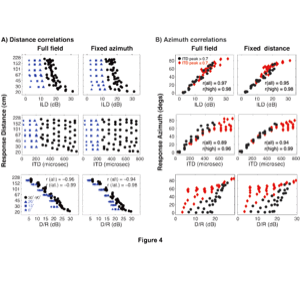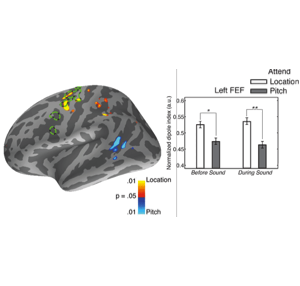
Behavioral Experiments
Behavioral experiments teach us what acoustic attributes are important for performing different tasks and what listeners are capable of achieving. We present listeners with carefully controlled sounds under headphones or from loudspeakers and explore their ability to detect sounds, identify stimuli, and extract meaning from the sound they hear.
Individual differences in the ability to selectively attend are unrelated to listener age, but differ greatly across listeners. Reverberant energy degrades performance for all listeners. (Dorea Ruggles)

Imaging
Electro-encephalography and magneto-encephalography allow us to measure synchronous electrical activity with great temporal precision. We combine anatomical MRI scans with M/EEG data to estimate what cortical regions generate observed activity. In addition to simple power analysis, we also look at functional connectivity and phase-locking to stimulus inputs in ongoing activity. Responses from the auditory brainstem can be revealed from the same measures, depending on the frequency range analyzed.
Combined M/EEG activity reveals attentional modulation of responses in auditory cortex contralateral to the attended source. Here, in response to the same pair of competing sound streams, the neural power at a given frequency is higher when it is the frequency contained in the attended, rather than the unattended stream. (Hari Bharadwaj and Adrian KC Lee)

Computational Approaches
Mathematics are important to many aspects of our work. We analyze the acoustics of the signals reaching the ears in order to deduce what properties are perceptually relevant. We use computational modeling to try to test our understanding of how information is encoded in various parts of the neural pathway. To make sense of inherently noisy neuroelectric data, we use various methods to extract reliable information, infer the sites of underlying neural activity, and explore how different neural areas coordinate their responses.
In reverberant space, sound localization in distance (left) and in direction (right) are related to different aspects of the stimuli a listener receives. Distance is closely related to the direct-to-reverberant energy ratio (bottom left), while azimuthal direction is closely related to interaural level differences (top right) and interaural time differences (middle right). (BGS-C)

Collaboration
We can't be experts in every approach, but we are lucky enough to know many talented collaborators interested in the kinds of questions we want to answer. With our collaborators, we employ fMRI, animal behavior, electrode neurophysiology, computational models, and other methods to explore auditory neuroscience.
In a collaboration with Prof. Adrian KC Lee (U Wash), we are using combined M/EEG to investigate how attention to different acoustic features alters the attentional control network. Holding the stimuli constant, we vary task demands and explore how this affects network activity during the behavior. In this image, we show what neural regions in the left hemisphere are more active when listeners direct attention to source location compared to source pitch. (Jing Xia, Sid Rajaram, and Hari Bharadwaj)